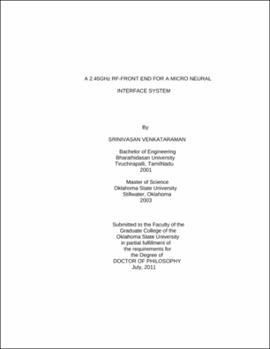| dc.contributor.advisor | Hutchens, Chris | |
| dc.contributor.author | Venkataraman, Srinivasan | |
| dc.date.accessioned | 2013-12-10T18:05:52Z | |
| dc.date.available | 2013-12-10T18:05:52Z | |
| dc.date.issued | 2011-07 | |
| dc.identifier.uri | https://hdl.handle.net/11244/7876 | |
| dc.description.abstract | Scope and Method of Study: | |
| dc.description.abstract | Active implants inside the human body should be capable of performing their intended function for decades without replacement with minimal tissue heating. It is therefore highly desirable for them to operate reliably and efficiently in a battery-less environment at very low power levels. Traditionally inductive coupling has been the preferred choice of power transfer to the active implants. Inductive coupling suffers from bandwidth and alignment issues that limit their usefulness for distributed sensor systems. The ability to use both near field and far-field RF to power and communicate with sensors distributed in the body would provide a major advance in implantable device technology. Recent advances in wafer packaging technologies and advanced VLSI processes together offer the possibility of a highly reliable system on chip (SOC) solution using RF energy as a source to power the active implants. This research work deals with the design and testing of a RF- Front end capable of harvesting up to 42µW at -3dBm power levels while providing 700mV and 400mV regulated DC voltages under 50µA and 4µA continuous load conditions respectively for signal conditioning electronics and control. In addition the RFIDS contains both an AM demodulator and a 400mV voltage reference. The RF front end chip occupies an area of 2.32 mm2 and has been fabricated in 180nm IBM CMRF7SF process. | |
| dc.description.abstract | Findings and Conclusions: | |
| dc.description.abstract | A power harvesting front end complete with LDOs, voltage reference, and demodulator suitable for operating at 2.45GHz for neural/biosensor applications capable of harvesting greater than 40µW at -3dBm of RF signal levels was presented. Regulated supplies of 700mV and 400mV supporting 54µA of total load current heavily weighted for analog signal conditioning, a Gen-2 compatible demodulator and 400mV voltage reference have been demonstrated. Measured results are within the process skew parameters of ± 10% with the exception of the voltage reference PSRR. Maximum measured regulated output voltage range for the LDOs is from -3dBm to -1dBm and with efficiencies greater than 8.4%. The harvester system presented here is a fully functioning regulated power system suitable for powering signal acquisition and data transmission hardware. | |
| dc.format | application/pdf | |
| dc.language | en_US | |
| dc.rights | Copyright is held by the author who has granted the Oklahoma State University Library the non-exclusive right to share this material in its institutional repository. Contact Digital Library Services at lib-dls@okstate.edu or 405-744-9161 for the permission policy on the use, reproduction or distribution of this material. | |
| dc.title | 2.45GHz RF-Front end for a micro neural interface system | |
| dc.contributor.committeeMember | Abdolvand, Reza | |
| dc.contributor.committeeMember | Ramakumar, R. | |
| dc.contributor.committeeMember | High, Karen | |
| osu.filename | Venkataraman_okstate_0664D_11612.pdf | |
| osu.accesstype | Open Access | |
| dc.type.genre | Dissertation | |
| dc.type.material | Text | |
| dc.subject.keywords | bio sensors | |
| dc.subject.keywords | cmos | |
| dc.subject.keywords | imlantable biomedical devices | |
| dc.subject.keywords | rfid | |
| dc.subject.keywords | system ona chip | |
| dc.subject.keywords | vlsi | |
| thesis.degree.discipline | Electrical Engineering | |
| thesis.degree.grantor | Oklahoma State University | |
